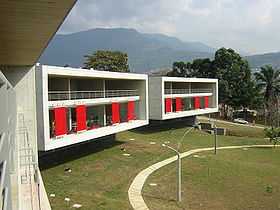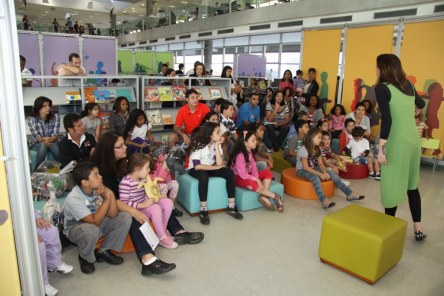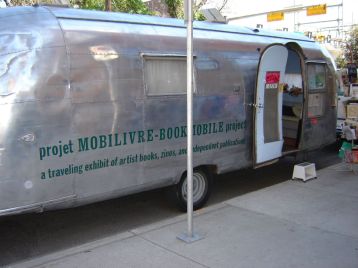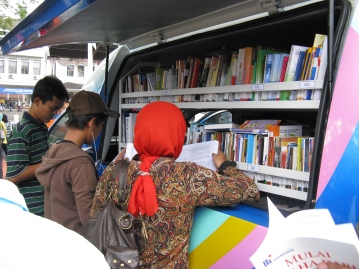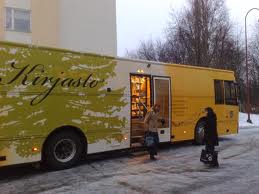Libraries as open, airy public spaces, flowing seamlessly into green outdoor public amenities. Placing the individual at their centre and designed to provide whatever the public wants in terms of learning and cultural opportunities.
Places where you can go just to feel the cool air conditioning or even sleep without being disturbed, but where members of staff will proactively engage you with the resources available when they can.
Open and engaging architecture with site-specific artworks and access to cutting edge technology in the poorest, most disadvantaged city neighbourhoods. It sounds like a futuristic utopian dream of the public library service… and it sort of is.
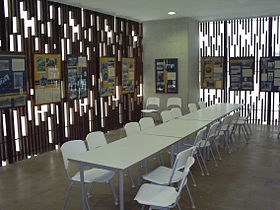
(Image: Wikipedia Commons, Parque Biblioteca España in Medellin, Colombia)
The Colombian city of Medellin has started a wave of public library development across South America.
The idea is simple: to create attractive, world class internal and external public spaces that seamlessly join together. To offer people opportunities to experience culture and learning in some of the poorest urban areas on the continent.
(Image: Wikipedia Commons, Parque Biblioteca La Ladera, Medellin, Colombia)
As the Mayor of Medellin puts it:
“The park libraries are cultural centers for social development that encourage citizen encounters, educational and recreational activities, building groups, the approach to the new challenges in digital culture. And they are also spaces for cultural services that allow cultural creation and strengthening of existing neighborhood organizations.” (source: Wikipedia)
When I read that, it really sounds like something we all need… but what is even more remarkable is the context in which this work is taking place. Other countries across the continent, including Brazil, have taken up the challenge of creating world class public libraries and public spaces in deprived areas with the kinds of challenges that would turn our blood cold in the UK.
Only 26% of the Brazilian population is fully literate. The infrastructural issues in addressing this level of need in a population of over 200 million spread over the fifth largest country in the world are huge. However, the work is already beginning in the favelas of Rio and São Paulo with the opening of new Park LIbraries.
Brazil doesn’t have a strong reading culture. Vera Saboya, Director of the new Rio State Public Library, expressed the challenge:
“Recently, when the Government of the State of Rio de Janeiro opened some Park Libraries over the city and the investments on these spaces were announced, people were often heard complaining that no one would be interested in books, that these spaces would stay empty… To the surprise of all, the spaces were immediately embraced by the communities, with a huge number of borrowed books, lots of research into the collection and many children and young people hanging around, with nothing to do, but to enjoy the peaceful and neutral environment. A new space was being launched, an almost revolutionary experience”

(Image: Biblioteca Parque Estadual Rio de Janeiro)
As she says “people are hungry for moments of non-productive leisure, of creative idleness”.
I absolutely love this characterisation of the public library purpose – especially in a country where even finding volunteers to support professional public library staff is a huge challenge due to economic necessities which mean that ‘leisure time’ is a rare luxury for most.
(A children’s story-telling session in the Biblioteca São Paulo)
In São Paulo, the Biblioteca São Paulo and the newly landscaped ‘Park of Youth’ have been constructed on the site of the infamous Carandiru Penitentiary where, in 1992, 111 prisoners died in a massacre by military police. Adriana Cybele Ferrari, Director of the new library described the challenge for this new library as:
“To build a library that could symbolize a new era for our State System of Public Libraries… To do something that could change the “face” of the libraries and how they are seen and noticed by the community. And also, to break the stigma that Brazilians do not get interested in reading and culture.”
It goes without saying that the library hopes to promote reading and writing – however, and I think this is the key point, Park Libraries aren’t designed around the books and information resources, they’re designed around people, as Ms Ferrari puts it:
“I believe that… the [Park] libraries have been trying to create a space for integration of people, not books. The best place is destined for each user to find out more about himself within this universe, which is primarily focused on reading and writing skills… but also tries to integrate the different kinds of reading around the world, either through image, movement, music or dance.”
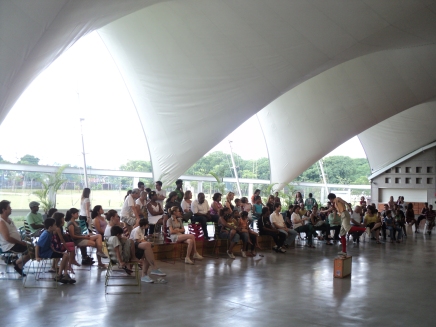
(Members of the public enjoying a free theatrical performance at Biblioteca São Paulo)
The park library is designed to meet people’s desire to engage with culture through multiple channels. It has a recording studio, cinema, free wifi access and facilitated activities and performances as well as up to date IT (the Bill and Melinda Gates Foundation has invested in the IT infrastructure in the Park Libraries in Colombia).
Biblioteca São Paulo is attempting to address the barrier of low literacy levels in the population by using digital technologies to convert any book that a member of the public brings to the library into an audio-book in one working day.
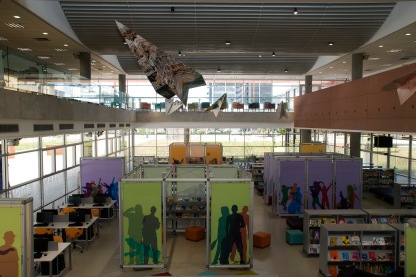
(A paper aeroplane flies above readers heads in the Biblioteca São Paulo)
In the Biblioteca Parque Estadual in Rio de Janeiro there are books flying through the air above people’s heads; giant books standing on their ends that are playthings and imaginary houses; books hanging from a magical book tree in the children’s section and toys alongside books in the section for very young children. The whole space feels irreverent and playful. They have gone to great lengths to demystify the public library space, making it open and accessible to as many people as possible.
I love the creative energy in these spaces, the recognition of the need for a civic space just to dream, to be a non-productive citizen, to simply be – but also to be open to new experiences, new ideas and new ways of being.
People love these spaces too, they flock to them and the case is being made for more and more to be built.
I love the combination of external and internal civic spaces and the format agnosticism of these cultural experiences.
I also love the no-holds-barred creative optimism – linked with a realistic understanding of what people want and need, rather than what they ought to have.
South America’s park libraries – magical realism at it’s very best.
(Cover image: Biblioteca São Paulo)
Thanks:
I would like to thank Felipe Arruda of the British Council in Brazil for his help in putting me in touch with the Directors of Biblioteca São Paulo and Biblioteca Estadual Parque Rio de Janeiro and for translating their responses to my questions.
The British Council is working with partners such as the National Literacy Trust and the Reading Agency in Britain to develop joint projects to promote literacy and a reading culture in Brazil.

